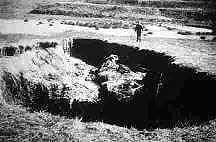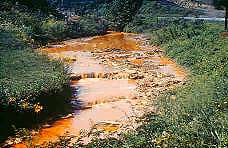
 Landslides represent the mass movement of rock and soil material downslope
due to gravity. Several factors contribute to triggering landslides, but
the most important ones are heavy rains, clay soil, and steep slopes. Our
studies indicate that there are nearly 500,000 landslides in the State and damage estimates are about 30 million
dollars annually (see our publication EGB-15). Earthquakes are not common in
West Virginia, but since 1758 there have been dozens that have occurred in
the Appalachians and felt in the State (see our publication EGB-12).
Subsidence is the collapse of the ground surface over a void, whether natural
or man-made. Two general conditions in the State cause subsidence: natural
collapse over limestone caves and caverns, and man-made collapse over coal
mines. Floods are common in West Virginia because of heavy rains and narrow
stream valleys. Some floods are also man-made, such as the Buffalo Creek
disaster in 1972 when an earthen dam broke.
Another hazard is radon, a natural radioactive decay product of
many rocks in the State. Much needs to be done to understand just which rock
types are the major contributors and what are the areal extent of these
rocks. Part of the problem of higher-than-normal radon in houses is the
specific construction of the houses: old or new? vented or not? cracks in
basements and walls? Radioactive decay is also a man-made problem due to the
need to dispose of low-level radioactive waste (LLW) from hospitals and
industry. Although West Virginia produces LLW, it is transported
out-of-state for disposal at the present time (see our publication C-21). In
the future, we may have to take care of it ourselves.
Landslides represent the mass movement of rock and soil material downslope
due to gravity. Several factors contribute to triggering landslides, but
the most important ones are heavy rains, clay soil, and steep slopes. Our
studies indicate that there are nearly 500,000 landslides in the State and damage estimates are about 30 million
dollars annually (see our publication EGB-15). Earthquakes are not common in
West Virginia, but since 1758 there have been dozens that have occurred in
the Appalachians and felt in the State (see our publication EGB-12).
Subsidence is the collapse of the ground surface over a void, whether natural
or man-made. Two general conditions in the State cause subsidence: natural
collapse over limestone caves and caverns, and man-made collapse over coal
mines. Floods are common in West Virginia because of heavy rains and narrow
stream valleys. Some floods are also man-made, such as the Buffalo Creek
disaster in 1972 when an earthen dam broke.
Another hazard is radon, a natural radioactive decay product of
many rocks in the State. Much needs to be done to understand just which rock
types are the major contributors and what are the areal extent of these
rocks. Part of the problem of higher-than-normal radon in houses is the
specific construction of the houses: old or new? vented or not? cracks in
basements and walls? Radioactive decay is also a man-made problem due to the
need to dispose of low-level radioactive waste (LLW) from hospitals and
industry. Although West Virginia produces LLW, it is transported
out-of-state for disposal at the present time (see our publication C-21). In
the future, we may have to take care of it ourselves.
 Landfills are necessary in all states to provide proper disposal of
garbage, so that the leachate generated from its decomposition does not
pollute the ground water. Environmental geology plays an important role in
identifying the proper rock, soil, topography, and water conditions so that
it can really be called a sanitary landfill. The location of a landfill
should avoid limestone, sandstone, and alluvium; avoid all steep slopes; and
avoid faults, fractures, and exposed bedding planes (see our publication EGB-1-7).
And like many environmental problems and hazards, the geologist must
realize that financial, social, and political aspects play major roles in any
decision process.
Water is our most essential mineral resource, providing drinking water,
navigation, recreation, and is indispensable for agriculture, industry, the
generation of electricity, and a host of other uses. In West Virginia, we use
about 25 to 30 billion gallons per day. Most of this water is not
consumed but returned almost immediately back to the creeks and rivers (see
our publications C-24, 28, 35, 37, 39, and 41).
Landfills are necessary in all states to provide proper disposal of
garbage, so that the leachate generated from its decomposition does not
pollute the ground water. Environmental geology plays an important role in
identifying the proper rock, soil, topography, and water conditions so that
it can really be called a sanitary landfill. The location of a landfill
should avoid limestone, sandstone, and alluvium; avoid all steep slopes; and
avoid faults, fractures, and exposed bedding planes (see our publication EGB-1-7).
And like many environmental problems and hazards, the geologist must
realize that financial, social, and political aspects play major roles in any
decision process.
Water is our most essential mineral resource, providing drinking water,
navigation, recreation, and is indispensable for agriculture, industry, the
generation of electricity, and a host of other uses. In West Virginia, we use
about 25 to 30 billion gallons per day. Most of this water is not
consumed but returned almost immediately back to the creeks and rivers (see
our publications C-24, 28, 35, 37, 39, and 41).
 Potable drinking water is probably the most important and one of the jobs of
environmental geology is to locate these sources, whether a nearby creek or a
location for a well. Water wells tap the ground water, but the geologist
must know the rock types and structure in order to properly locate a well
site that may produce enough water to provide the needs of a household or
development. The pollution of surface and ground water is a constant problem
in West Virginia, primarily due to sewage and acid mine drainage. Large
sewage treatment plants and small septic tank systems are the domain of the
State Health Department and their use is increasing, although they are
expensive. Acid mine drainage has been studied extensively and again,
treatment is improving, but the cost factors are large. Although the
environmental geologist does get involved with these last two areas, they are
primarily under the regulatory control of other State agencies.
Environmental geology uses many of the specialties of geology such as
stratigraphy, structure, hydrology, and related areas of chemistry, physics,
biology, and mining methods. All of these disciplines assist in one way or
another to solve a problem or provide a solution to a situation in
environmental geology. It then becomes the job of the environmental
geologist to synthesize and piece together the critical information in a
format for the homeowner, government agency, or a public group to comprehend.
(by Peter Lessing, July 1996)
Potable drinking water is probably the most important and one of the jobs of
environmental geology is to locate these sources, whether a nearby creek or a
location for a well. Water wells tap the ground water, but the geologist
must know the rock types and structure in order to properly locate a well
site that may produce enough water to provide the needs of a household or
development. The pollution of surface and ground water is a constant problem
in West Virginia, primarily due to sewage and acid mine drainage. Large
sewage treatment plants and small septic tank systems are the domain of the
State Health Department and their use is increasing, although they are
expensive. Acid mine drainage has been studied extensively and again,
treatment is improving, but the cost factors are large. Although the
environmental geologist does get involved with these last two areas, they are
primarily under the regulatory control of other State agencies.
Environmental geology uses many of the specialties of geology such as
stratigraphy, structure, hydrology, and related areas of chemistry, physics,
biology, and mining methods. All of these disciplines assist in one way or
another to solve a problem or provide a solution to a situation in
environmental geology. It then becomes the job of the environmental
geologist to synthesize and piece together the critical information in a
format for the homeowner, government agency, or a public group to comprehend.
(by Peter Lessing, July 1996)
Please send questions, comments, and/or suggestions to webmaster.
Page created and maintained by:
West Virginia Geological and Economic Survey
Address: Mont Chateau Research Center
1 Mont Chateau Road
Morgantown, WV 26508-8079
Telephone: 1-800-WV-GEOLOgy (1-800-984-3656) or 304-594-2331
FAX: 304-594-2575
Hours: 8:00 a.m. - 5:00 p.m. EST, Monday - Friday
Permission to reproduce this material is granted if acknowledgment is given to the West Virginia Geological and Economic Survey.